“], “filter”: { “nextExceptions”: “img, blockquote, div”, “nextContainsExceptions”: “img, blockquote, a.btn, a.o-button”} }”>
Heading out the door? Read this article on the new Outside+ app available now on iOS devices for members!
>”,”name”:”in-content-cta”,”type”:”link”}}”>Download the app.
The right cookware can make or break your backcountry cooking game—it’s hard to sear trout in a flimsy aluminum skillet or boil water in a tall, narrow pot. For this guide, we set out to find cookware that goes the extra mile, from ultralight one-person setups to versatile nesting sets that can handle multiple courses and cooking styles. If it saved time, money, or impressed us with functionality and durability, it was a contender for this competitive list. Here are our picks for the best backcountry pots and pans.
At a Glance
Best Pot Set
GSI Halulite Dualist HS
$90 at REI $90 at GSI
Weight: 1.4 lbs (655 g)
Volume: 1.8 L
Pros and Cons
⊕ Efficient heat exchanger
⊕ Includes nesting bowls, mugs, and sporks
⊕ Packs neatly
⊗ Heavy
Nesting more neatly than a Russian matryoshka doll, this all-in-one set includes everything needed for two people, with enough space to fit a 100 gram canister-style stove inside. But what truly sets it apart is the heat sink design of the aluminum pot: A corrugated heat exchanger on the bottom delivers handily on its promise to boil water faster. Paired with a good canister stove like the Soto Windmaster, it takes around 2.5 minutes to boil a liter of water—a whopping 3 minutes faster than a traditional pot. This is especially handy at elevation, where water takes longer to boil.
On an overnight canoe trip in Washington’s Puget Sound, the Halulite Dualist HS’s compact, nested bundle came in especially handy when the vessel was crammed to capacity with firewood and a cooler. Unlatch the insulated pot handle, which functions like a locking mechanism, and you’ll find two sets of mugs, bowls, and plastic sporks packed neatly inside. Sip-tops and insulated sleeves on the mugs are a nice touch, and protected our testers’ fingers when wolfing down bowls of chili and sipping their morning coffee.
The tall sides and relatively compact size (just under 2 liters) make this pot better suited for boiling water than other cooking tasks, though a hard-anodized aluminum construction did a better job than titanium competitors of achieving a rolling simmer without incinerating the food at the bottom of the pot. The downside to that material choice? It’s relatively heavy, weighing 12 ounces, and a total of 1.4 pounds including the flatware. But with this pot’s efficient heat exchanger design, the weight you save toting a smaller gas canister might just break even.
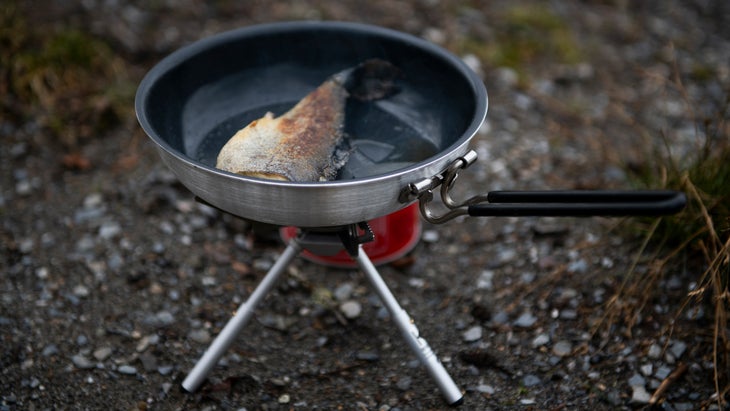
Best Skillet
GSI Bugaboo Ceramic Frypan (8 in.)
$29 at REI $29 at Backcountry
Weight: 12.8 oz
Pros and Cons
⊕ Durable nonstick surface
⊕ Even heat distribution
⊕ Collapsable handle
⊗ Heavy
For anglers, backpacking trips often lead directly to a trout-filled alpine lake. And when the fishing gods smile upon you with a mess of trout, you’d be wise to cook it properly. During a late summer trip to Washington’s Mount Baker Wilderness, GSI’s Bugaboo Ceramic Frypan had the chops for just that. That’s thanks to its generous 8-inch diameter, sturdy, silicone-wrapped collapsible handle, and non-stick ceramic coating.
It’s well-suited for more than just fish; eggs, which I consider the ultimate test of a nonstick surface’s capability, slide around like a hockey puck. Another benefit of the non-stick coating is that it’s very forgiving if you accidentally scorch your food—stuck-on trout skin washed off easily with minimal scrubbing.
This skillet’s relatively heavy aluminum construction withstood occasional abuse with little more than a few cosmetic scratches. It suffers from the same problem that plagues all nonstick cookware, however: its coating will eventually wear off. It also requires a bit more diligence to make sure the coating doesn’t get hammered by metal objects in your pack, so if you’re particularly rough on your gear, nonstick cookware may not be the best option.
But if you like to incorporate fresh ingredients—like a fish straight out of a lake—into your trail diet, having a proper aluminum skillet like the Bugaboo Ceramic Frypan for the job goes a long way towards elevating your backcountry cooking game.
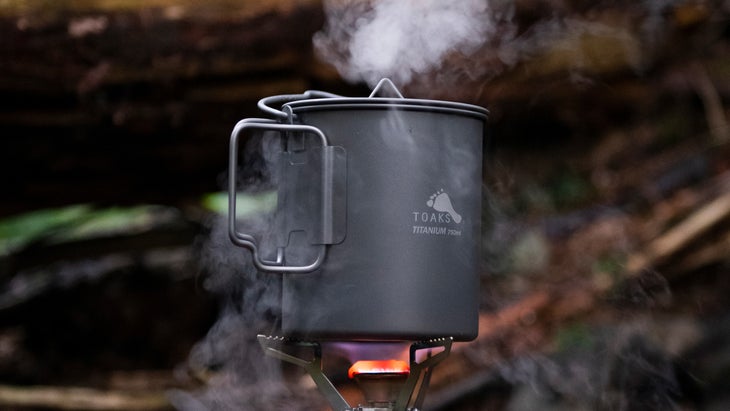
Best for Solo Backpackers
Toaks Titanium 750ml Pot with Bail Handle
$27 at REI $27 at Amazon
Weight: 3.9 oz
Volume: 750 ml
Pros and Cons
⊕ Extremely light
⊕ Durable
⊕ Bail handle adds versatility
⊕ Great value
⊗ Very minimalist
For such a simple piece of cookware, this compact titanium pot was a surprising hit among small groups and solo testers. It weighs about the same amount as a deck of cards, is large enough to fit a 100-gram fuel canister and a small stove, and still manages to come in at a budget price.
Testers loved the detachable bail handle, which not only makes handling a hot pot easier, but also means you can hang it over an open fire should your fuel source go dry. I put this to the test cooking soup over an open flame, and though using the bail handle in this manner can be a bit sketchy, titanium doesn’t retain heat as well as other materials, so you’re less likely to burn yourself in the process.
Embedded measurements inside the pot remove the guesswork, and while the lid isn’t anything special, it fits snugly and includes a pull tab. As with other titanium pots, it’s extremely durable and doesn’t absorb odors or flavor, so your coffee won’t taste like beef stew.
Unlike its titanium competitors, however, the 750ml Pot lacks the hefty price tag. Titanium can be notoriously expensive, but somehow Toaks keeps the price point right around $30. You won’t be cooking elaborate gourmet backcountry meals with this slightly-larger-than-pint-sized pot, but for the solo backpacker who wants to keep their setup as simple, compact, and light as possible, it’s hard to beat.
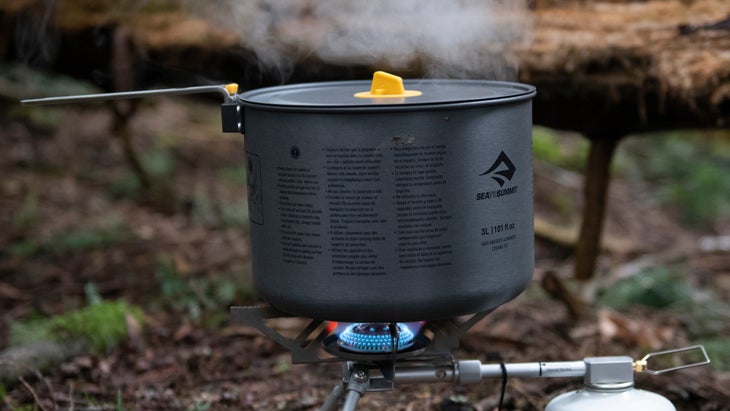
Best For Larger Groups
Sea to Summit Frontier Ultralight Pot (3L)
$75 at REI $75 at Backcountry
Weight: 10.7 oz
Volume: 3L
Pros and Cons
⊕ Nonstick ceramic coating
⊕ Large capacity
⊕ Nests easily with smaller pots
⊗ Handle can be finicky
When it comes to cooking anything non-liquid, camp cookware suffers from a major drawback: The intense heat output from most camp stoves quickly chars food on the bottom, leaving the top layer (and your feelings) lukewarm. When you’re cooking large amounts of food, this problem is only exacerbated. That’s where the Frontier Ultralight Pot stood out. The hard-anodized aluminum alloy construction and ceramic coating provided even, stick-free heat while keeping weight down.
That nonstick coating did a stellar job keeping food from burning and making clean-up a breeze: During a trip into Washington’s North Cascades, it effortlessly handled a batch of mac and cheese, a well-known precursor to hopelessly burnt-on scraps. And the three-liter capacity was enough to allow a group of four to use a single pot, cutting down on the total amount of cookware needed for the three-day trip.
Thoughtful details, like embedded measurement markings, a secure-fitting lid with strainer holes, and a lid clip pot attachment (to keep it out of the dirt while stirring) simplify the cooking process. Our only beef? The detachable handle, which was finicky to attach and easy to lose.
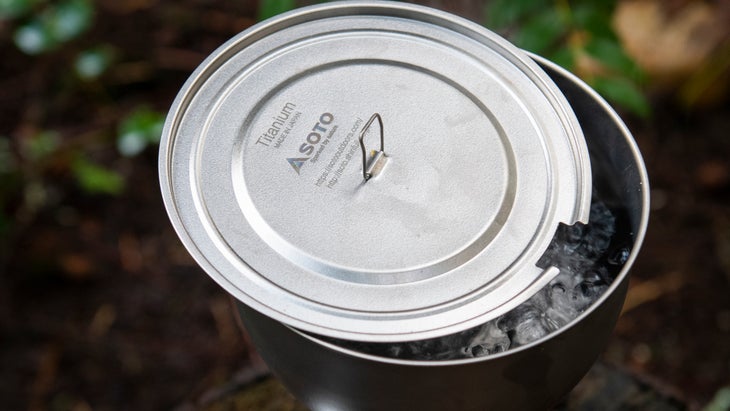
Best Ultralight Pot
Soto Titanium Pot 1100
$45 at REI $45 at Soto
Weight: 3.2 oz (with lid)
Volume: 1.1 L
Pros and Cons
⊕ Good value
⊕ Extremely light
⊕ Wide base
⊗ No built-in handle
⊗ Prone to hot spots
If shaving ounces is your absolute top priority, this featherweight, ultra-thin titanium pot is an excellent choice at a great price point. This is the lightest pot we tested, and one of the lightest for its size on the market, period. The relatively wide, 6.1-inch base adds stability and also creates enough room to pack a fuel canister and a small stove inside. There’s no built-in handle, but the supplied pot-lifter gets the job done while keeping your hands safe. (The downside: We tended to lose it in our packs.) Given its thin, all-titanium build, the 1100 is prone to hot spots, especially with canister-style stoves. That means a higher risk of scorching food if you’re not careful, as one tester found out the hard way after attempting to cook black bean soup in Washington’s North Cascades. With that in mind, this pot is best suited for small groups looking to rehydrate meals or boil water for coffee on chilly mornings.
Other Products We Tested
- Snow Peak Ti-Mini Solo Combo 2.0 ($87): This set performed as well as you would expect of any high-quality titanium pot, but comes with a hefty price tag—nearly triple the Toaks Titanium 750ml pot.
- Jetboil Summit Skillet ($45): This skillet shares many attributes with the GSI Bugaboo Ceramic Frypan: They’re similar in size, weight, intended use, and performance. The Summit Skillet is significantly more expansive, however, and the included plastic spatula melted from the heat of the pan.
- GSI Halulite Tea Kettle ($30): There are advantages to using a quick-boiling tea kettle over a pot, but unfortunately, more disadvantages.
Products to Avoid
- Sea to Summit Detour Stainless Steel One Pot Cook Set ($200): The pop-up silicon sides of this set work great for storage, and as one tester noted, are “very cute.” But the pot was prone to folding down on itself while full of boiling water (not very cute).
- Solo Stove Pot 1800/900 ($45/35): There’s nothing inherently bad about these pots, but for their basic stainless steel design, there are better, lighter, and cheaper options that make them a difficult sell.
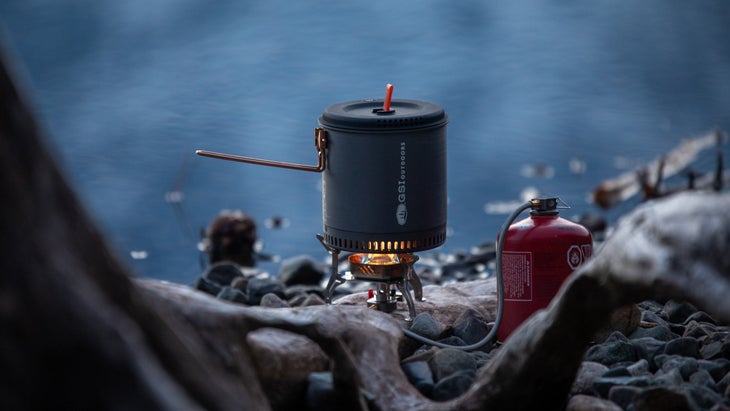
How to Choose the Right Setup
Cooking style: If boiling water for coffee or dehydrated meals is your top priority, a simple pot made of titanium, aluminum, or stainless steel will last for years. If you’re planning on cooking actual food, it’s worth considering pots and pans with a nonstick coating. These require some extra care and attention, but the coating helps keep food from sticking to the bottom and burning, and makes dish-duty much easier.
Size and weight: We’d all rather have a lighter pack, but cutting weight usually means sacrificing performance elsewhere. How much you’re willing to sacrifice is entirely personal, but shaving a few ounces often comes at the cost of heat transfer, user-friendliness, and durability.
Pot design: The pots that can boil water the fastest have one thing in common: a heat exchanger, or some variation of corrugated metal fins on the bottom of the pot. This transfers heat far more efficiently, cutting boiling time by half in some cases. It adds a small amount of extra weight, though any gains by choosing a lighter pot may be offset by the need to carry extra fuel. Pot width also plays a factor in boiling time—a wider bottom allows for more surface area to be in contact with the flame, heating the contents faster. It’s also worth considering how well other gear, such as fuel and a stove, can nest together inside.
Materials: The best material for cookware depends on your cooking needs, weight preferences, and budget. The three most common are:
- Titanium: The lightest and most expensive material. It’s also a poor distributor of heat, which can lead to hot spots and burnt food, making it best for boiling water.
- Aluminum: For most backpackers, this is the best option. It’s slightly heavier than titanium, but cheaper and distributes heat more evenly and efficiently.
- Stainless Steel: The most durable cookware material, stainless steel transfers heat with a similar efficiency as aluminum. Durability comes at the cost of weight. Unless you have a knack for destroying cookware, aluminum will likely meet your needs just fine.
- Nonstick coatings: Like death and taxes, it’s a certainty that all nonstick coatings will eventually wear out. Avoid using metal utensils on nonstick surfaces and put a cloth or bandana in-between pots and pans to avoid scratches. If you tend to abuse your gear, nonstick may not be the best option.
How We Test
- Products tested: 11
- Testers: 5
- Minor burns: 2
- Biggest cooking disaster: A collapsible pot collapsing on itself while full of boiling water.
- Biggest group: 6
- Fishing rods lost to the lake: 1
We tested the newest pots and pans in Washington, California, and Colorado. We then stacked them up against our tried-and-true favorites for revelation. This test was conducted simultaneously with our backpacking stoves category, enabling us to try each pot and pan with a variety of different stoves.
Our testers ranged from novice cooks who prefer an efficient, no-fuss backcountry meal to those who wouldn’t think of leaving home without a spice jar. Factors we considered that made our top picks stand out were size and weight, efficiency, versatility, durability, and budget. Some products stood out for being able to handle a wide range of tasks reasonably well, while others stood out for doing just one thing.
Meet Our Testers
Nick Cote is a photographer and writer based in Bellingham, Washington. He is the author of Wild Eats: Campsite Cooking and is a frequent recipe contributor to Backpacker. His work has also been published in The New York Times, The Washington Post, The Wall Street Journal, Outside, and many others.
Dylan Warren is a wandering photographer in constant pursuit of deep snow and good dirt. His adventures have taken him from New York to Alaska, and everywhere in between. When he settles down, he splits his time between Lake Tahoe, Bellingham, and New York City.
Related
Best Backpacking Stoves
The Best Ultralight Packs
The Best Ultralight Sleeping Bags and Quilts
